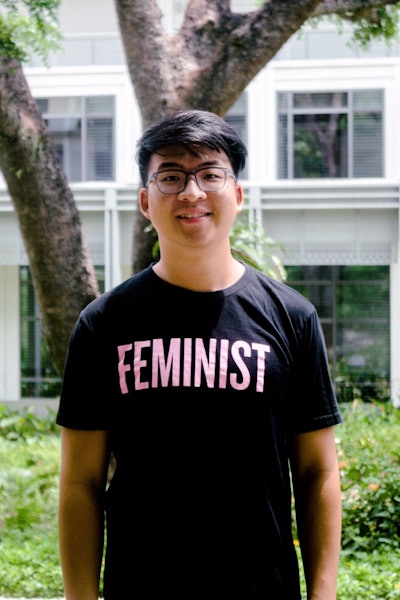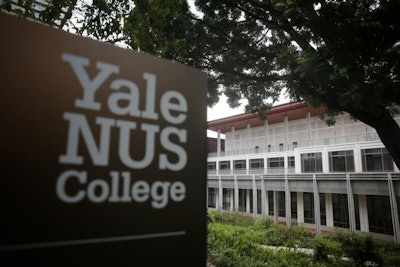In 2014, Daryl Yang started his first year as an undergraduate student at a new residential liberal arts institution in Singapore called Yale-NUS College. The school opened its doors for the first time in 2011 and was hailed as a groundbreaking partnership between Yale University and the National University of Singapore (NUS), two top research universities spanning two corners of the globe.
Yang grew up in Singapore and, at 21, enrolled at Yale-NUS because he wanted a liberal arts education in his home country. At the time, Yale-NUS was the only such school in the country. The only other option for Yang was to go abroad for an expensive degree, taking on more student debt than he could afford.
He also chose Yale-NUS for another reason: to be part of a LGBTQ+ student community.
“When Yale-NUS was starting up, there was all this talk about the college being more open to LGBTQ+ students,” says Yang, who became president of the college’s gender and sexuality student group, known as G-Spot. “So, I thought there would be an opening for me to do more for the queer community at the college. To shape the future of how students engage with each other on campus.”
 Daryl Yang
Daryl Yang
But now the partnership between the institutions is ending, after only eight years.
On August 27, 2021, almost three years after Yang graduated, NUS announced the Yale-NUS College experiment will come to an end, because NUS has decided to pull out of the partnership. The current first-year class at Yale-NUS set to graduate in 2025 will be the last alumni cohort. By June 2025, Yale-NUS is expected to roll into another NUS initiative called the University Scholars Programme to form a new interdisciplinary honors college called the New College.
NUS declined an interview to comment further on the decision, though the decision stunned Yale-NUS College’s president, Dr. Tan Tai Yong, who told the college’s student newspaper, The Octant, that he was “gobsmacked and flabbergasted.”
Complicated cultural nuances
The original agreement between the two institutions allowed for either party to withdraw in 2025, but students and administrators say the decision came down without warning.
“There was a sense of being betrayed and lied to. The NUS president has his strategic vision for NUS, and it was like we were just next in line on the chopping block,” says Yihao Xie, a member of the inaugural Yale-NUS class. “There was no warning. No sign that this was being considered at all. They swept us away with little care for everyone. I don’t really know why.”
Dr. Tang Eng Chye, president of NUS, said in an official statement that the decision is part of broader institutional restructuring plans. According to NUS, the New College aims to be more accessible to students and expand enrollment, particularly to Singapore residents.
Yale president Peter Salovey said in a statement that he is proud of what the institutions were able to accomplish together in such a short time and expressed his “gratitude for the generous support of the Government of Singapore in making it possible for us to partner in the creation of a model of liberal arts education that is regarded as one of the most innovative in the world — one whose DNA will live on, we trust, in new and exciting ways.”
Yang is sad to see his alma mater shut its doors so soon and concerned for the future of LGBTQ+ students.
“Yale-NUS opened up spaces for queer students that never would have happened if the school hadn’t existed,” he says. “The campus kickstarted a buzz of queer student activism that spread across other universities in Singapore. But now I worry those spaces are gone.”
“The announcement really worries me for the future of a queer-friendly campus environment for students,” he continues. “When I found out about the merger, I was trying to figure out why it happened, if it had to do with growing student activism. If that was maybe seen as a threat. We don’t know if that was a factor. But I can’t help but wonder.”

“I’m a little worried that when we talk about queer issues at Yale-NUS, there can be a narrative that Yale liberated us. That’s not what happened,” says Yang. “It was students here who led the agenda to make a safer, more open space for queer identities. This wasn’t a ‘West saved Southeast Asia’ situation. Students drove this forward, and the Yale-NUS administration supported them.”
The New College, as of this reporting, does not plan to offer gender-neutral housing, which Yang says is part of what troubles him.
“The larger picture is we just don’t know how much autonomy this new institution will have,” he says. “Yale-NUS essentially did its own thing. With Yale’s departure, will this New College still have that? It’s unclear if this new institution will be as committed to diversity and inclusion, especially for queer students.”
He holds out some hope, though, for what comes next in the New College.
“There are planning committees about the merger with student representatives from queer student groups,” says Yang. “So, I hope their needs will be taken seriously. It would be useful if the NUS president and Yale-NUS president also reassured people that the new institution will uphold the values of Yale-NUS.”
To Dr. Bryan Penprase, a founding faculty member at Yale-NUS College and now a professor of physics and astronomy at Soka University, acknowledges the merger’s reasons may still be unclear. But he cautioned against seeing the decision as the Singaporean government clamping down on free expression.
“I think a lot of Americans will jump on a sinister motivation of curtailing academic freedom,” says Penprase. “I don’t agree with that because it oversimplifies the situation. Whether there was good motivation or not, I can’t say for sure. But this is definitely a loss. Any institution is ultimately more than a bunch of courses and faculty lines. It’s a set of shared values. It’s a set of relationships. All that is being shattered.”
“Some of the suspicion is that Yale trained a bunch of free thinkers, and Singapore didn’t like that,” says Dr. Jason Lane, dean of Miami University’s College of Education, Health, and Society. “We don’t know if that is true.
“There is at least a forward-facing effort to try to reflect issues of inclusion on some of these branch campuses as communicated via the home campus, but we all know that these things are very situational,” Lane says. “But at the end of the day, these partnerships are business transactions for an educational model. They either make more money to subsidize the government or they don’t.”
Unmet expectations
According to Chye’s statement, the finances of Yale-NUS factored into the decision to dissolve the arrangement but were not the main factor. The Singaporean government for years had indeed been subsidizing Yale-NUS, where the tuition was twice as high as that of the much-larger NUS. Yale-NUS had a 1:8 faculty-to-student ratio. At NUS, that ratio was roughly double. Yale-NUS also had been falling short of fundraising goals, reaching less than a quarter of a $300 million target to build up its endowment.
“We don’t know exactly what happened behind the scenes,” says Lane. “We do know a lot of governments invest in these campuses thinking they will become self-sustaining models more quickly than they do. Many branch campuses have closed because they didn’t meet financial expectations. They didn’t bring enough tuition revenue or the government subsidizing the institution did not get enough of a return on its investment.”
Other international partnerships between universities in the U.S. and abroad have faced similar funding issues in the last decade or so, Lane points out.
Penprase added that, to him, this merger does not reflect the institution’s lack of academic success. Yale-NUS boasted a 6% acceptance rate and a highly internationally diverse student population that went on to secure prestigious fellowships and graduate school spots.
“This should not in any sense be seen as a sign of Yale-NUS failing,” he says. “But what didn’t happen was for that success to be sustained. Maybe if there was more distance between NUS and Yale-NUS, or if Yale-NUS had its own standalone campus, then it could have. But the fact that it existed as part of the NUS campus may have made this more complicated.”
Compatibility considerations
Higher ed analysts still believe the announcement may illustrate some complex cross-continental nuances at play. Dr. Kris Olds, a professor of geography at the University of Wisconsin-Madison, researches different partnership methods in higher ed, and he outlines key factors that institutions should consider before embarking on a relationship. He has noticed many
Regardless, Olds says successful partnerships require both sides to be invested.
“Sometimes on the American side, people think that the partner will be happy to have you there because you’re an institution with a well-known name,” he says, noting a global fixation on problematic university rankings can be pronounced in Asia. “But partnering is serious work. If a partnership is under-resourced and underrecognized on the U.S. side, then Asian institutions will get irritated that you’re not as committed.”
This merger has raised questions within U.S. higher education about the political, cultural and financial complexities of global partnerships such as Yale-NUS. However, such partnerships vary greatly in their models and geopolitical relationships. Experts say the case of Yale-NUS cannot be generalized, because such partnerships vary greatly in their models and geopolitical relationships. But there are lessons to be learned from the Yale-NUS fallout, Penprase says.
“I want to underline and bold the importance of any new startup project to consider carefully the needs of the partner institution and the partner country — and to consider the culture of the region in which one is working,” he says. “It’s very, very difficult to build a new college from scratch. A lot is moving fast, and that makes it easy to forget to step back.”
Experts warn against seeing Yale-NUS as a harbinger of a demise of such relationships across borders, especially at this moment when global ties are increasingly important to research and society.
“It’s important to keep in mind that Yale-NUS is not exemplary of what is happening with global partnerships,” says Dr. Hans de Wit, professor and director of Boston College’s Center for International Higher Education. “There is much still working around the world that is positive. We can only hope that these collaborations will continue.”
De Wit offers successful examples, such as the COVID-19 vaccine’s development among members of the international scientific community. He argues these relationships are needed more than ever to address global crises, including climate change as well as the ongoing pandemic.
“The world is globalizing by necessity, even though there is this counter with nationalism,” says de Wit. “So, how can we still be open and collaborate on initiatives like the liberal arts, but not say, hey, you have to do it our way or we will stop working with you. You have to find a balance between our values and theirs to make it work.”
Navigating cross-continental differences
Experts agree, that no matter the partnership model, navigating geopolitical tensions will likely be another inevitable challenge.
“Universities have this orientation where it’s good for them to cross borders, to exchange ideas, to stay open,” says Dr. Simon Marginson, professor of international higher education at Oxford University, where he directs the Centre for Global Higher Education. “Because that’s their nature as institutions. Knowledge is international, and so universities will always be seen with some suspicion in geopolitics when tensions between countries arise.”
For example, growing nationalist-leaning politics in Singapore may have influenced at least in some part the Yale-NUS decision, Marginson says. The New College student population will consist of about 10% international students compared to approximately 40% at Yale-NUS. So that means most of the New College’s students will be Singaporean residents.
Lane adds that government resources or priorities anywhere can shift quickly.
“When you get in bed with the government, you have to realize they can be fickle partners,” he says. “One day you’re the favorite partner, the next day you’re not.”
But it doesn’t mean a partnership isn’t worth pursuing. If anything, it may be all the more reason to build one and try to work through such difficulties.
“I think anyone in higher education who moves overseas has to look at the benefits and the potential challenges,” says Lane. “Is it more valuable to not engage at all or to engage partly but to at least engage?”
Still, within the landscape of international higher education, the biggest players are shifting quickly.
“The halo or brand power of having a U.S. degree is not the same as it once was,” says Dr. Jenny Lee, professor of educational policy studies and practice at the University of Arizona.
This is in part because of larger forces at work.
“What we’re observing throughout the world is universities increasing their own capacity to be international institutions,” said Lee. “As countries develop their own higher education, there may also be less demand for students to go to the U.S. and more demand for the U.K., Australia and other English-speaking programs. The U.S. is not the only choice.”
Caution in the international community
There’s a related phenomenon also happening, which the Trump administration brought to the fore with aggressive foreign relations, including a travel ban that impacted international students in the U.S. The rise in anti-Asian hate crimes in the U.S. also put many in the global community on edge, raising questions of whether the U.S. is the right partner or the right destination for Asian students.
“Does an international branch campus become a safer place to pursue an American degree without having to worry about things like a travel ban suddenly happening?” says Lane. “I don’t know how that will play out.”
Lane says he is watching the “changing dance partners” in this partnership arena. The Hungarian government, for instance, has recently been working with Shanghai and China’s Fudan University to build a branch campus in Budapest.
“These partnerships have historically been a largely Western-driven enterprise,” says Lane. “The leading exporters have been the U.S., U.K, Australia and France. But that could be shifting. I’m interested in whether we’ll see more expansions of branch campuses from places like China or Russia.”
Xie says plans for international partnerships can sometimes miss an opportunity for deeper collaborations.
“There’s a problem when some U.S. university partnerships focus so much on trying to enter a major market,” says Xie. “You hear people say China is on the rise, so we need to understand those markets to do business there, and these partnerships will help. But what you don’t hear as much is, are we doing something to the partner’s benefit as well?”
Regardless of what the future holds, Xie wishes that the end of this particular partnership had been handled differently.
“I feel a terrible loss,” he said. “The exit strategy should have been discussed a lot sooner. But it’s hard. How do you tell students that their school in a few years will no longer exist?”
This article originally appeared in the November 11, 2021 edition of Diverse. Read it here.
















